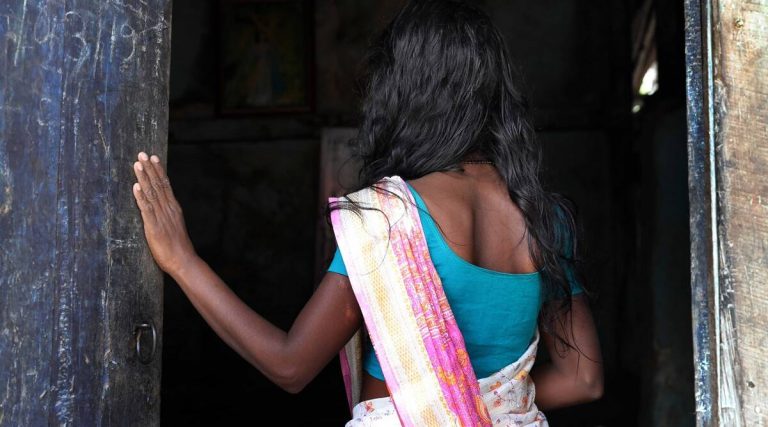
The common thread that runs through Ray’s treatment of prostitution is its organic evolution as an integral, indivisible act within the evolution of a society
By Nazarul Islam
India’s great film director Satyajit Ray never took the path of lengthy descriptions. Yet, you can see—even feel—it all happening. That’s enough to bring out the goose pimples!’ Clearly, here the filmmaker in Ray gave him an edge over other writers. His words were brief, simple and lucid. But the impression that emerged was extraordinarily rich in detail.
Satyajit Ray’s films often see him as a social commentator. Without taking a moralistic stance it is as if his characters reflect social realities that he observes around him. It was true of his portrayal of the sex worker in three of his films as well.
In Ashani Sanket (Distant Thunder), Chutki, a poor girl from a lower caste is pulled into prostitution by hunger which the brickfield agent takes advantage of during the infamous Bengal Famine in 1943 during World War II.
Historians now establish that it was totally man-made as the British administration hoarded rice to feed soldiers about to arrive in the East. When the Brahmin’s wife Ananga who Chutki is very fond of, guesses what is happening, she refuses Chutki’s offer of rice from her ‘earnings’ though her family is equally hungry. “What can I do? I always feel hungry,” Chutki defends herself.
She runs away to the city with the agent perhaps to disappear in the red light district eventually.
Ashani Sanket (1973) based on Bibhuti Bhusan Bandopadhyay’s novel, offers an insight into a rural woman’s desperate response to hunger. When driven to starvation, Chutki, unlike Moti who dies of starvation, or Ananga, who adjusts to the grim reality, is prepared to exchange sexual favours for a fistful of rice from a hideous, scarred man she abhors.
Conditioned morals of a patriarchal society mean little to Chutki when hunger stares her in the face. Women like Chutki are not uncommon in contemporary India. Ray perhaps can be credited with the first non-voyeuristic but sensitive look at prostitution in the Indian context through cinema.
In Pratidwandi (The Adversary,1970) Ray introduces his viewers to a different kind of sex worker. She holds a job as a qualified nurse but moonlights as a sex worker. Much against his will, the hero Siddhartha Choudhury, a medical college dropout due to his father’s sudden death and depleting finances, is introduced to her by his friend Adinath.
It’s obvious that he is uncomfortable in her presence and is surprised to find that she is actually a nurse. Is Siddhartha scared to reveal in his friend’s presence that he is a virgin? Or is his discomfort rooted in the fact that he is not easy in the company of females?
The woman speaks in a flirtatious, even mocking tone, and comes out in a bra and petticoat. When she finds that Siddhartha is nervous, she asks him for a cigarette. She is quite open about her double life and it appears that she manages to keep the two occupations apart. This woman is not into prostitution out of poverty but wants to earn some extra dough. Perhaps she has a family to take care of? Ray leaves it unsaid.
Rather he offers a glimpse of the rapidly changing scenario in Kolkata where an educated man like Siddhartha cannot land a job despite a good academic record, suspects his own sister of compromising with her boss in order to become a model, and where a qualified nurse takes to sex work as just one more source of earning.
The common thread that runs through Ray’s treatment of prostitution is its organic evolution as an integral, indivisible act within the evolution of a society now overrun with greed, consumerism and corruption not necessarily in that order.
His Jana Aranya (The Middleman, 1976) is a scathing comment on the erosion of values arising partly out of a decadent education system and partly out of unemployment and associated corrupt practices encroaching into the lives of the urban middle-class.
In Jana Aranya, Ray also offers a glimpse of the system of disguised prostitution in Kolkata. The climax of the film suggests that the hero has reduced himself to prostituting his conscience to eke out a livelihood through meagre contracts gained at the cost of procuring a woman for the contractor.
If you take some words at random and put them together, it becomes gibberish, and everyone who knows the meaning of words knows it as such. But if you take unrelated moving images and string them together, there will always be some people who will hold that the resultant strip of celluloid aims at some profundity.
He, therefore, is as much, if not more, a prostitute than the prostitute he procures for his prospective clients.
All three films denote, in subtle ways, different periods in the social history of Bengal in general and Kolkata in particular, how even prostitution becomes almost a normal feature in the big churn.
[author title=”Nazarul Islam” image=”https://sindhcourier.com/wp-content/uploads/2021/05/Nazarul-Islam-2.png”]The Bengal-born writer Nazarul Islam is a senior educationist based in USA. He writes for Sindh Courier and the newspapers of Bangladesh, India and America. He is author of a recently published book ‘Chasing Hope’ – a compilation of his 119 articles.[/author]